LHA1004: Analyzing Leadership Style & Job Satisfaction Research
VerifiedAdded on 2023/06/04
|7
|1304
|452
Report
AI Summary
This paper presents a critical analysis of a quantitative research article by Ronit Bogler, focusing on the influence of leadership style on teacher job satisfaction. The critique assesses the research problem, questions, variables, hypotheses, sampling methods, and internal validity. The study examines the relationship between principals' leadership styles (transformational or transactional), decision-making policies (autocratic versus participative), and teachers' job satisfaction. The sample consisted of 930 teachers in Israel schools, with a response rate of 80%. The analysis evaluates the instruments used for data collection, including questionnaires and surveys, and discusses the statistical results, highlighting the influence of teachers' perceptions of their occupation on their job satisfaction. The critique also addresses limitations related to generalization and factor loadings, suggesting areas for future research. This document is available on Desklib, a platform offering a wide range of study tools for students.
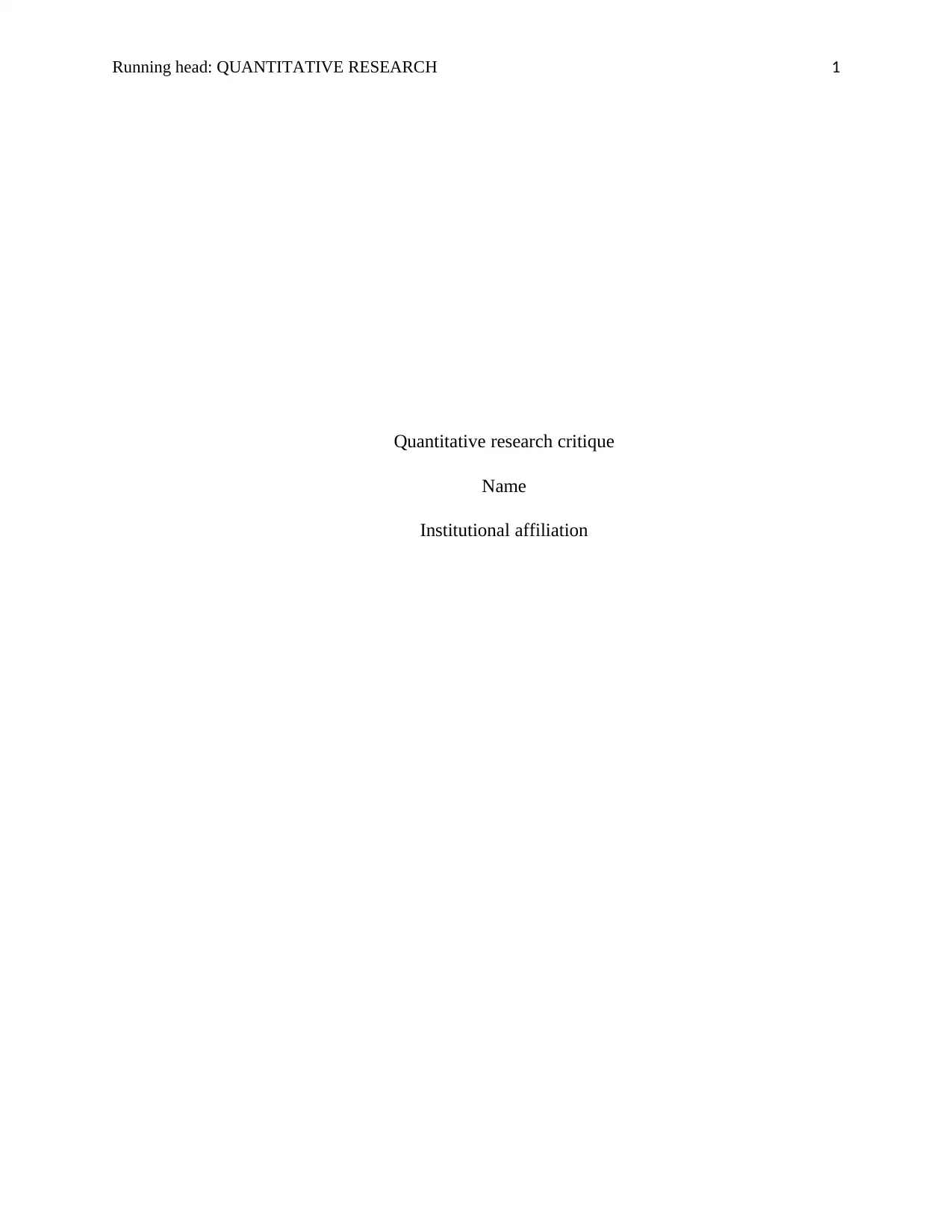
Running head: QUANTITATIVE RESEARCH 1
Quantitative research critique
Name
Institutional affiliation
Quantitative research critique
Name
Institutional affiliation
Paraphrase This Document
Need a fresh take? Get an instant paraphrase of this document with our AI Paraphraser
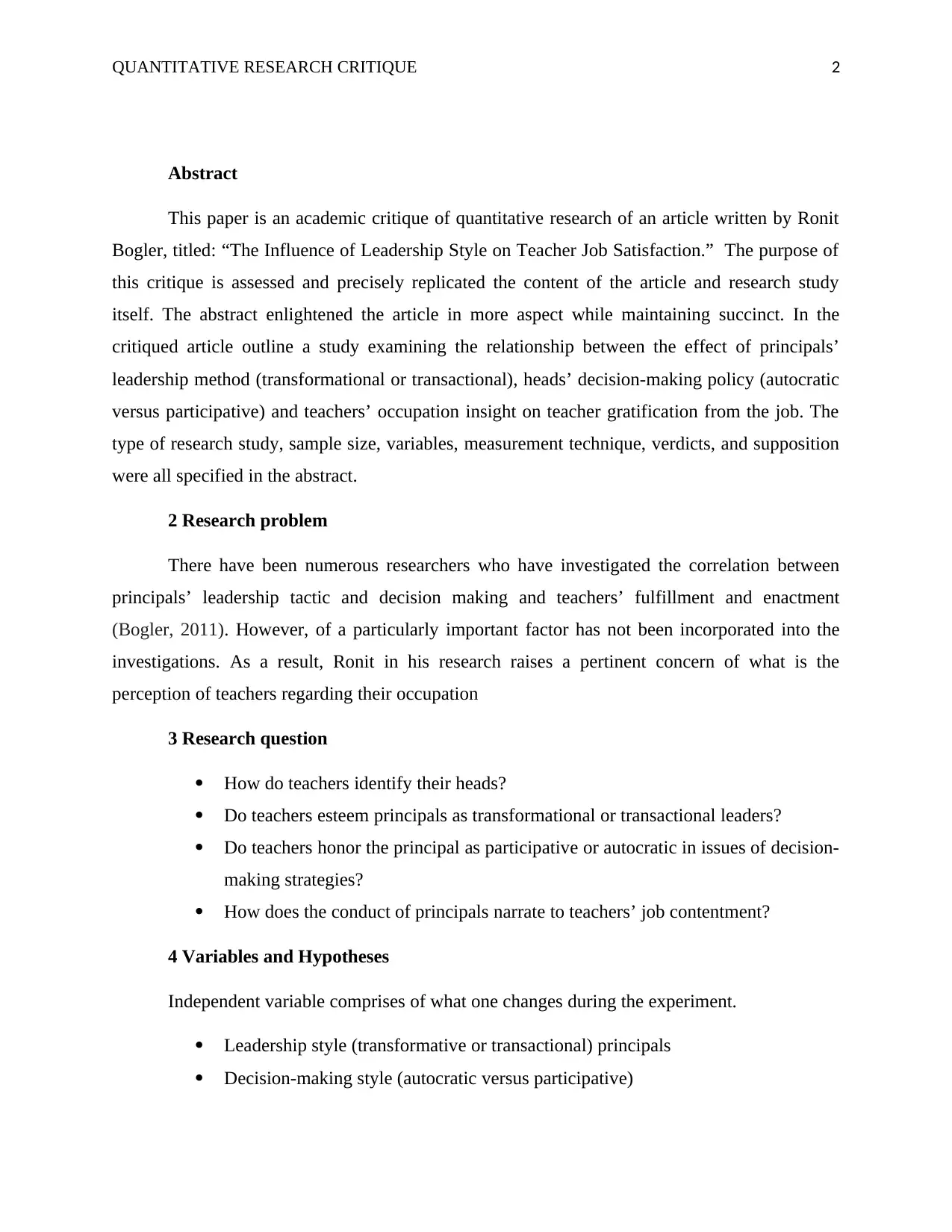
QUANTITATIVE RESEARCH CRITIQUE 2
Abstract
This paper is an academic critique of quantitative research of an article written by Ronit
Bogler, titled: “The Influence of Leadership Style on Teacher Job Satisfaction.” The purpose of
this critique is assessed and precisely replicated the content of the article and research study
itself. The abstract enlightened the article in more aspect while maintaining succinct. In the
critiqued article outline a study examining the relationship between the effect of principals’
leadership method (transformational or transactional), heads’ decision-making policy (autocratic
versus participative) and teachers’ occupation insight on teacher gratification from the job. The
type of research study, sample size, variables, measurement technique, verdicts, and supposition
were all specified in the abstract.
2 Research problem
There have been numerous researchers who have investigated the correlation between
principals’ leadership tactic and decision making and teachers’ fulfillment and enactment
(Bogler, 2011). However, of a particularly important factor has not been incorporated into the
investigations. As a result, Ronit in his research raises a pertinent concern of what is the
perception of teachers regarding their occupation
3 Research question
How do teachers identify their heads?
Do teachers esteem principals as transformational or transactional leaders?
Do teachers honor the principal as participative or autocratic in issues of decision-
making strategies?
How does the conduct of principals narrate to teachers’ job contentment?
4 Variables and Hypotheses
Independent variable comprises of what one changes during the experiment.
Leadership style (transformative or transactional) principals
Decision-making style (autocratic versus participative)
Abstract
This paper is an academic critique of quantitative research of an article written by Ronit
Bogler, titled: “The Influence of Leadership Style on Teacher Job Satisfaction.” The purpose of
this critique is assessed and precisely replicated the content of the article and research study
itself. The abstract enlightened the article in more aspect while maintaining succinct. In the
critiqued article outline a study examining the relationship between the effect of principals’
leadership method (transformational or transactional), heads’ decision-making policy (autocratic
versus participative) and teachers’ occupation insight on teacher gratification from the job. The
type of research study, sample size, variables, measurement technique, verdicts, and supposition
were all specified in the abstract.
2 Research problem
There have been numerous researchers who have investigated the correlation between
principals’ leadership tactic and decision making and teachers’ fulfillment and enactment
(Bogler, 2011). However, of a particularly important factor has not been incorporated into the
investigations. As a result, Ronit in his research raises a pertinent concern of what is the
perception of teachers regarding their occupation
3 Research question
How do teachers identify their heads?
Do teachers esteem principals as transformational or transactional leaders?
Do teachers honor the principal as participative or autocratic in issues of decision-
making strategies?
How does the conduct of principals narrate to teachers’ job contentment?
4 Variables and Hypotheses
Independent variable comprises of what one changes during the experiment.
Leadership style (transformative or transactional) principals
Decision-making style (autocratic versus participative)
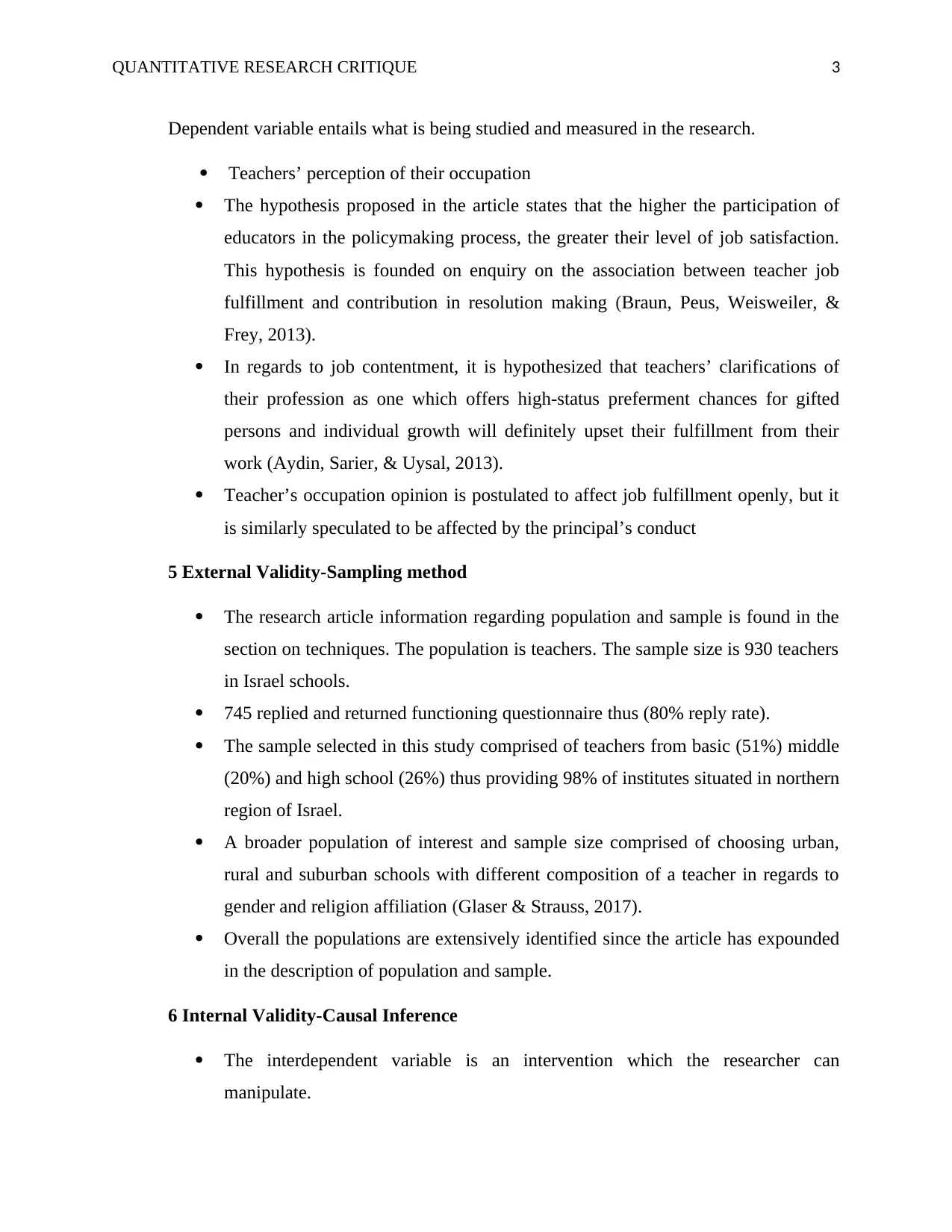
QUANTITATIVE RESEARCH CRITIQUE 3
Dependent variable entails what is being studied and measured in the research.
Teachers’ perception of their occupation
The hypothesis proposed in the article states that the higher the participation of
educators in the policymaking process, the greater their level of job satisfaction.
This hypothesis is founded on enquiry on the association between teacher job
fulfillment and contribution in resolution making (Braun, Peus, Weisweiler, &
Frey, 2013).
In regards to job contentment, it is hypothesized that teachers’ clarifications of
their profession as one which offers high-status preferment chances for gifted
persons and individual growth will definitely upset their fulfillment from their
work (Aydin, Sarier, & Uysal, 2013).
Teacher’s occupation opinion is postulated to affect job fulfillment openly, but it
is similarly speculated to be affected by the principal’s conduct
5 External Validity-Sampling method
The research article information regarding population and sample is found in the
section on techniques. The population is teachers. The sample size is 930 teachers
in Israel schools.
745 replied and returned functioning questionnaire thus (80% reply rate).
The sample selected in this study comprised of teachers from basic (51%) middle
(20%) and high school (26%) thus providing 98% of institutes situated in northern
region of Israel.
A broader population of interest and sample size comprised of choosing urban,
rural and suburban schools with different composition of a teacher in regards to
gender and religion affiliation (Glaser & Strauss, 2017).
Overall the populations are extensively identified since the article has expounded
in the description of population and sample.
6 Internal Validity-Causal Inference
The interdependent variable is an intervention which the researcher can
manipulate.
Dependent variable entails what is being studied and measured in the research.
Teachers’ perception of their occupation
The hypothesis proposed in the article states that the higher the participation of
educators in the policymaking process, the greater their level of job satisfaction.
This hypothesis is founded on enquiry on the association between teacher job
fulfillment and contribution in resolution making (Braun, Peus, Weisweiler, &
Frey, 2013).
In regards to job contentment, it is hypothesized that teachers’ clarifications of
their profession as one which offers high-status preferment chances for gifted
persons and individual growth will definitely upset their fulfillment from their
work (Aydin, Sarier, & Uysal, 2013).
Teacher’s occupation opinion is postulated to affect job fulfillment openly, but it
is similarly speculated to be affected by the principal’s conduct
5 External Validity-Sampling method
The research article information regarding population and sample is found in the
section on techniques. The population is teachers. The sample size is 930 teachers
in Israel schools.
745 replied and returned functioning questionnaire thus (80% reply rate).
The sample selected in this study comprised of teachers from basic (51%) middle
(20%) and high school (26%) thus providing 98% of institutes situated in northern
region of Israel.
A broader population of interest and sample size comprised of choosing urban,
rural and suburban schools with different composition of a teacher in regards to
gender and religion affiliation (Glaser & Strauss, 2017).
Overall the populations are extensively identified since the article has expounded
in the description of population and sample.
6 Internal Validity-Causal Inference
The interdependent variable is an intervention which the researcher can
manipulate.
⊘ This is a preview!⊘
Do you want full access?
Subscribe today to unlock all pages.

Trusted by 1+ million students worldwide
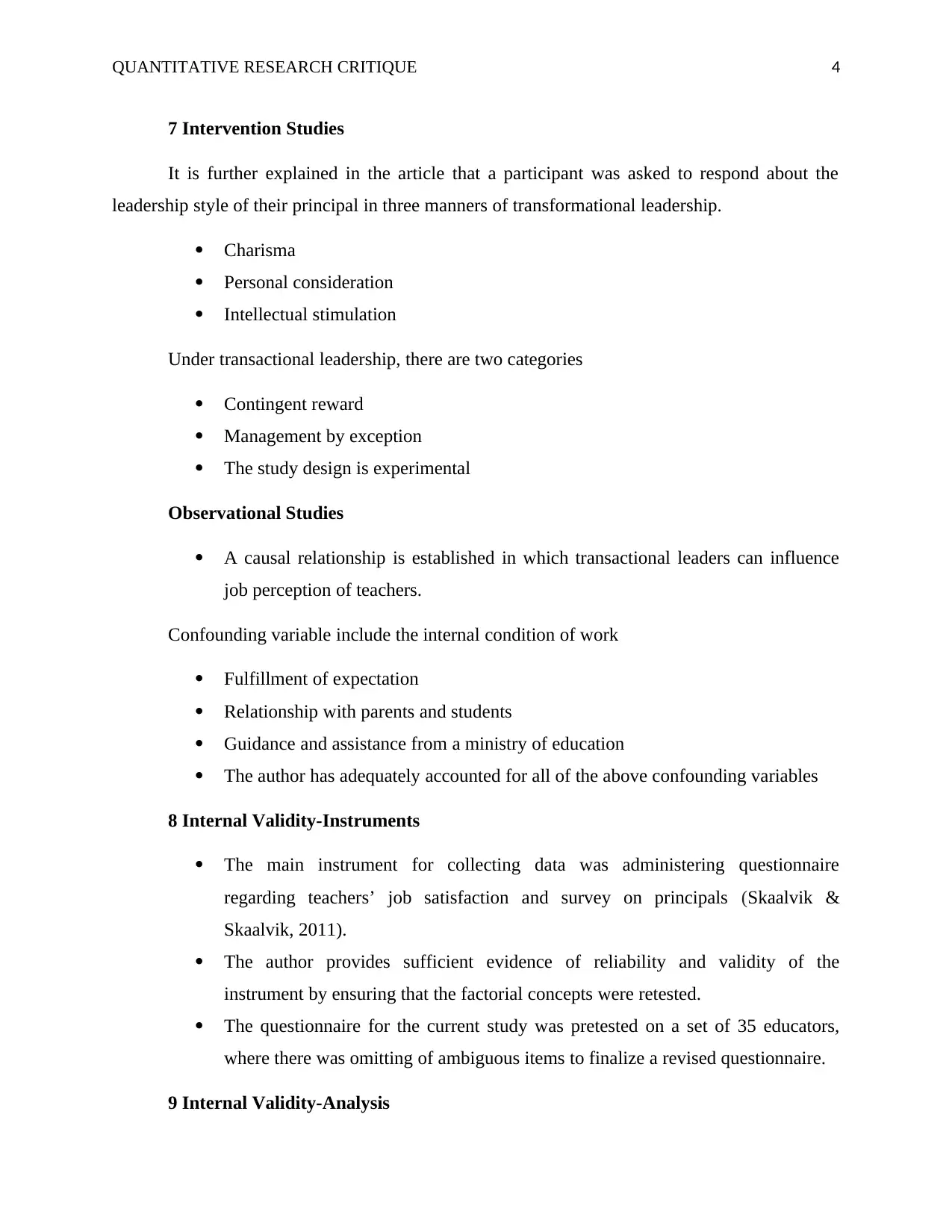
QUANTITATIVE RESEARCH CRITIQUE 4
7 Intervention Studies
It is further explained in the article that a participant was asked to respond about the
leadership style of their principal in three manners of transformational leadership.
Charisma
Personal consideration
Intellectual stimulation
Under transactional leadership, there are two categories
Contingent reward
Management by exception
The study design is experimental
Observational Studies
A causal relationship is established in which transactional leaders can influence
job perception of teachers.
Confounding variable include the internal condition of work
Fulfillment of expectation
Relationship with parents and students
Guidance and assistance from a ministry of education
The author has adequately accounted for all of the above confounding variables
8 Internal Validity-Instruments
The main instrument for collecting data was administering questionnaire
regarding teachers’ job satisfaction and survey on principals (Skaalvik &
Skaalvik, 2011).
The author provides sufficient evidence of reliability and validity of the
instrument by ensuring that the factorial concepts were retested.
The questionnaire for the current study was pretested on a set of 35 educators,
where there was omitting of ambiguous items to finalize a revised questionnaire.
9 Internal Validity-Analysis
7 Intervention Studies
It is further explained in the article that a participant was asked to respond about the
leadership style of their principal in three manners of transformational leadership.
Charisma
Personal consideration
Intellectual stimulation
Under transactional leadership, there are two categories
Contingent reward
Management by exception
The study design is experimental
Observational Studies
A causal relationship is established in which transactional leaders can influence
job perception of teachers.
Confounding variable include the internal condition of work
Fulfillment of expectation
Relationship with parents and students
Guidance and assistance from a ministry of education
The author has adequately accounted for all of the above confounding variables
8 Internal Validity-Instruments
The main instrument for collecting data was administering questionnaire
regarding teachers’ job satisfaction and survey on principals (Skaalvik &
Skaalvik, 2011).
The author provides sufficient evidence of reliability and validity of the
instrument by ensuring that the factorial concepts were retested.
The questionnaire for the current study was pretested on a set of 35 educators,
where there was omitting of ambiguous items to finalize a revised questionnaire.
9 Internal Validity-Analysis
Paraphrase This Document
Need a fresh take? Get an instant paraphrase of this document with our AI Paraphraser
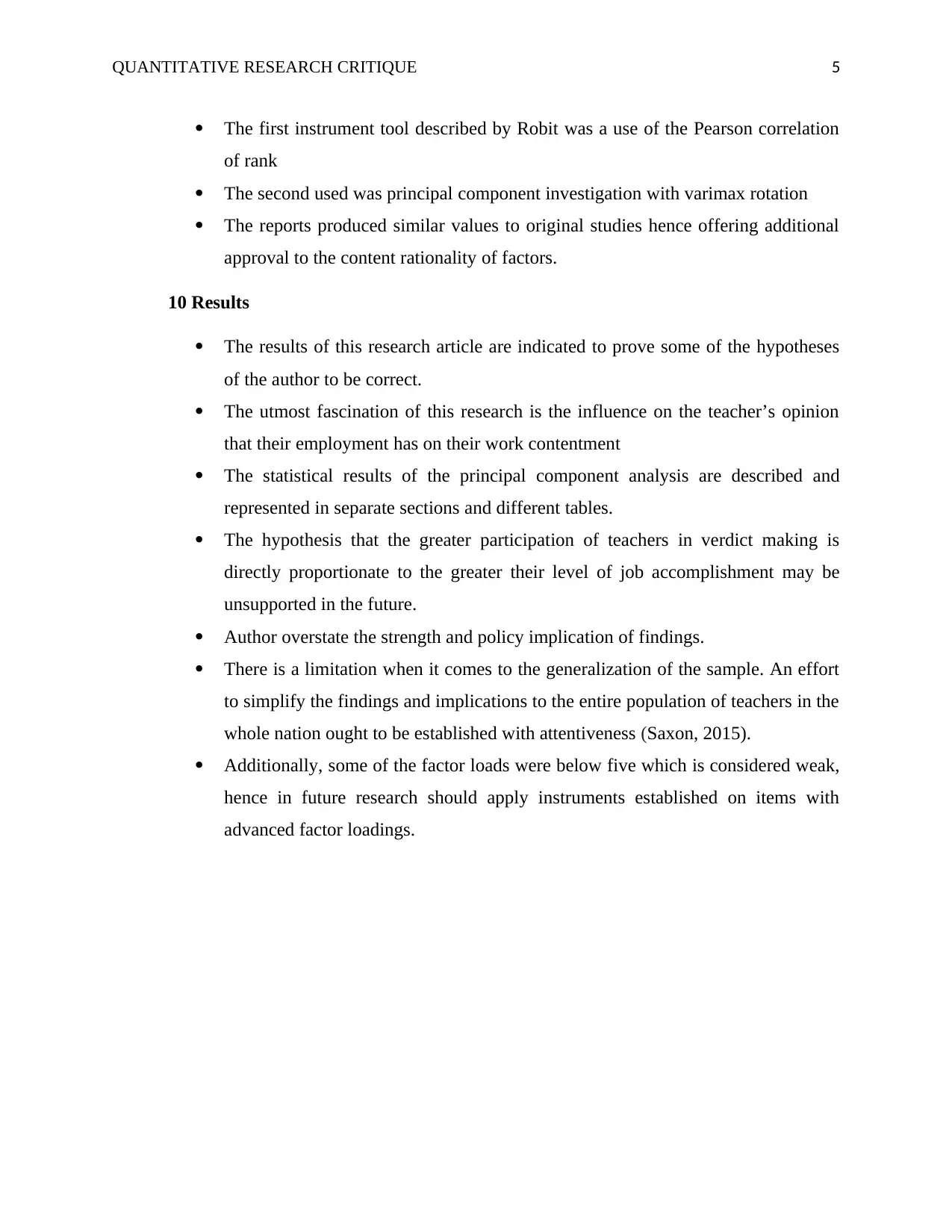
QUANTITATIVE RESEARCH CRITIQUE 5
The first instrument tool described by Robit was a use of the Pearson correlation
of rank
The second used was principal component investigation with varimax rotation
The reports produced similar values to original studies hence offering additional
approval to the content rationality of factors.
10 Results
The results of this research article are indicated to prove some of the hypotheses
of the author to be correct.
The utmost fascination of this research is the influence on the teacher’s opinion
that their employment has on their work contentment
The statistical results of the principal component analysis are described and
represented in separate sections and different tables.
The hypothesis that the greater participation of teachers in verdict making is
directly proportionate to the greater their level of job accomplishment may be
unsupported in the future.
Author overstate the strength and policy implication of findings.
There is a limitation when it comes to the generalization of the sample. An effort
to simplify the findings and implications to the entire population of teachers in the
whole nation ought to be established with attentiveness (Saxon, 2015).
Additionally, some of the factor loads were below five which is considered weak,
hence in future research should apply instruments established on items with
advanced factor loadings.
The first instrument tool described by Robit was a use of the Pearson correlation
of rank
The second used was principal component investigation with varimax rotation
The reports produced similar values to original studies hence offering additional
approval to the content rationality of factors.
10 Results
The results of this research article are indicated to prove some of the hypotheses
of the author to be correct.
The utmost fascination of this research is the influence on the teacher’s opinion
that their employment has on their work contentment
The statistical results of the principal component analysis are described and
represented in separate sections and different tables.
The hypothesis that the greater participation of teachers in verdict making is
directly proportionate to the greater their level of job accomplishment may be
unsupported in the future.
Author overstate the strength and policy implication of findings.
There is a limitation when it comes to the generalization of the sample. An effort
to simplify the findings and implications to the entire population of teachers in the
whole nation ought to be established with attentiveness (Saxon, 2015).
Additionally, some of the factor loads were below five which is considered weak,
hence in future research should apply instruments established on items with
advanced factor loadings.
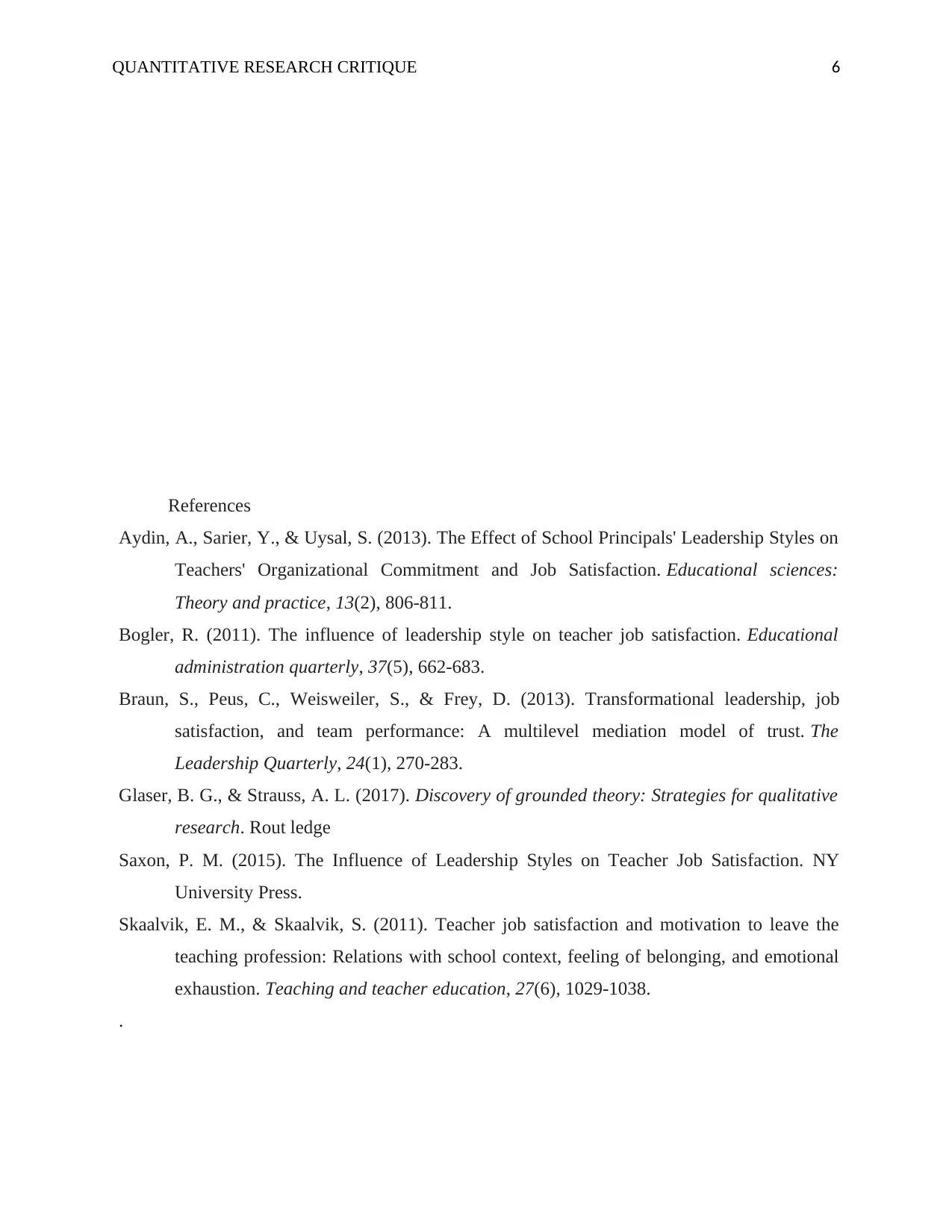
QUANTITATIVE RESEARCH CRITIQUE 6
References
Aydin, A., Sarier, Y., & Uysal, S. (2013). The Effect of School Principals' Leadership Styles on
Teachers' Organizational Commitment and Job Satisfaction. Educational sciences:
Theory and practice, 13(2), 806-811.
Bogler, R. (2011). The influence of leadership style on teacher job satisfaction. Educational
administration quarterly, 37(5), 662-683.
Braun, S., Peus, C., Weisweiler, S., & Frey, D. (2013). Transformational leadership, job
satisfaction, and team performance: A multilevel mediation model of trust. The
Leadership Quarterly, 24(1), 270-283.
Glaser, B. G., & Strauss, A. L. (2017). Discovery of grounded theory: Strategies for qualitative
research. Rout ledge
Saxon, P. M. (2015). The Influence of Leadership Styles on Teacher Job Satisfaction. NY
University Press.
Skaalvik, E. M., & Skaalvik, S. (2011). Teacher job satisfaction and motivation to leave the
teaching profession: Relations with school context, feeling of belonging, and emotional
exhaustion. Teaching and teacher education, 27(6), 1029-1038.
.
References
Aydin, A., Sarier, Y., & Uysal, S. (2013). The Effect of School Principals' Leadership Styles on
Teachers' Organizational Commitment and Job Satisfaction. Educational sciences:
Theory and practice, 13(2), 806-811.
Bogler, R. (2011). The influence of leadership style on teacher job satisfaction. Educational
administration quarterly, 37(5), 662-683.
Braun, S., Peus, C., Weisweiler, S., & Frey, D. (2013). Transformational leadership, job
satisfaction, and team performance: A multilevel mediation model of trust. The
Leadership Quarterly, 24(1), 270-283.
Glaser, B. G., & Strauss, A. L. (2017). Discovery of grounded theory: Strategies for qualitative
research. Rout ledge
Saxon, P. M. (2015). The Influence of Leadership Styles on Teacher Job Satisfaction. NY
University Press.
Skaalvik, E. M., & Skaalvik, S. (2011). Teacher job satisfaction and motivation to leave the
teaching profession: Relations with school context, feeling of belonging, and emotional
exhaustion. Teaching and teacher education, 27(6), 1029-1038.
.
⊘ This is a preview!⊘
Do you want full access?
Subscribe today to unlock all pages.

Trusted by 1+ million students worldwide

QUANTITATIVE RESEARCH CRITIQUE 7
1 out of 7
Your All-in-One AI-Powered Toolkit for Academic Success.
+13062052269
info@desklib.com
Available 24*7 on WhatsApp / Email
![[object Object]](/_next/static/media/star-bottom.7253800d.svg)
Unlock your academic potential
Copyright © 2020–2025 A2Z Services. All Rights Reserved. Developed and managed by ZUCOL.